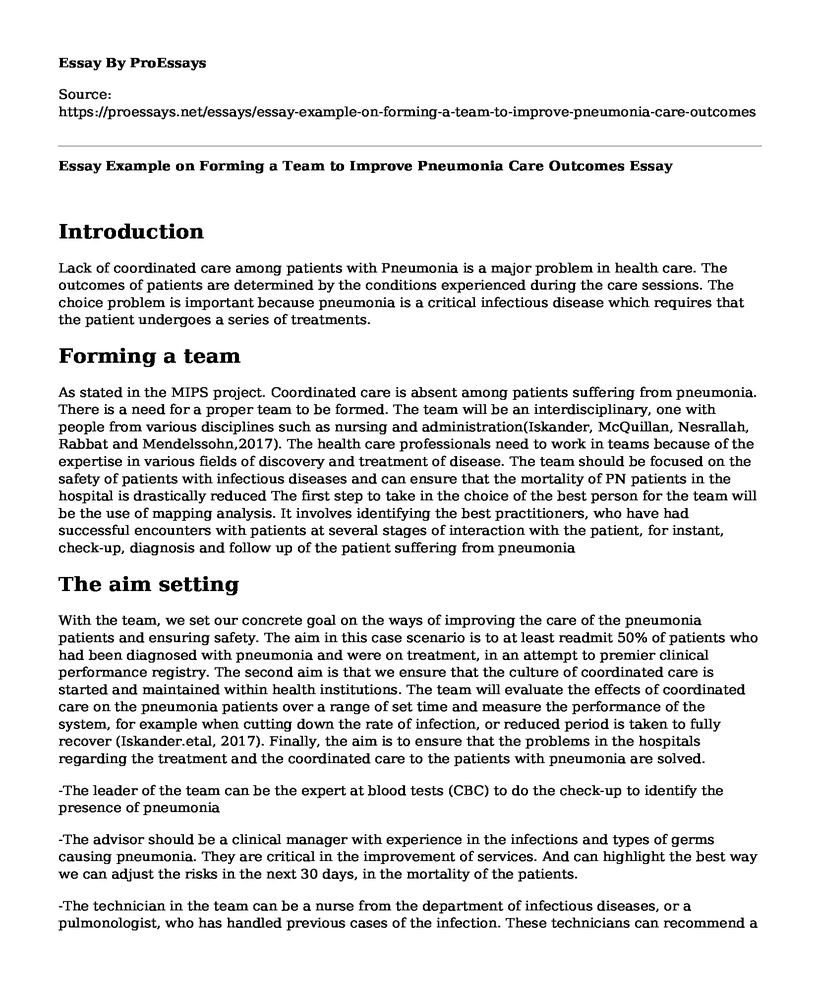Introduction
Lack of coordinated care among patients with Pneumonia is a major problem in health care. The outcomes of patients are determined by the conditions experienced during the care sessions. The choice problem is important because pneumonia is a critical infectious disease which requires that the patient undergoes a series of treatments.
Forming a team
As stated in the MIPS project. Coordinated care is absent among patients suffering from pneumonia. There is a need for a proper team to be formed. The team will be an interdisciplinary, one with people from various disciplines such as nursing and administration(Iskander, McQuillan, Nesrallah, Rabbat and Mendelssohn,2017). The health care professionals need to work in teams because of the expertise in various fields of discovery and treatment of disease. The team should be focused on the safety of patients with infectious diseases and can ensure that the mortality of PN patients in the hospital is drastically reduced The first step to take in the choice of the best person for the team will be the use of mapping analysis. It involves identifying the best practitioners, who have had successful encounters with patients at several stages of interaction with the patient, for instant, check-up, diagnosis and follow up of the patient suffering from pneumonia
The aim setting
With the team, we set our concrete goal on the ways of improving the care of the pneumonia patients and ensuring safety. The aim in this case scenario is to at least readmit 50% of patients who had been diagnosed with pneumonia and were on treatment, in an attempt to premier clinical performance registry. The second aim is that we ensure that the culture of coordinated care is started and maintained within health institutions. The team will evaluate the effects of coordinated care on the pneumonia patients over a range of set time and measure the performance of the system, for example when cutting down the rate of infection, or reduced period is taken to fully recover (Iskander.etal, 2017). Finally, the aim is to ensure that the problems in the hospitals regarding the treatment and the coordinated care to the patients with pneumonia are solved.
-The leader of the team can be the expert at blood tests (CBC) to do the check-up to identify the presence of pneumonia
-The advisor should be a clinical manager with experience in the infections and types of germs causing pneumonia. They are critical in the improvement of services. And can highlight the best way we can adjust the risks in the next 30 days, in the mortality of the patients.
-The technician in the team can be a nurse from the department of infectious diseases, or a pulmonologist, who has handled previous cases of the infection. These technicians can recommend a Pnc6 for accessed self-assistance telecare.
Reference
Iskander, C., McQuillan, R., Nesrallah, G., Rabbat, C., & Mendelssohn, D. C. (2017). Attitudes and opinions of Canadian nephrologists toward continuous quality improvement options. Canadian journal of kidney health and disease, 4, 2054358117725295. https://journals.sagepub.com/doi/abs/10.1177/2054358117725295
Cite this page
Essay Example on Forming a Team to Improve Pneumonia Care Outcomes. (2023, Apr 09). Retrieved from https://proessays.net/essays/essay-example-on-forming-a-team-to-improve-pneumonia-care-outcomes
If you are the original author of this essay and no longer wish to have it published on the ProEssays website, please click below to request its removal:
- Breastfeeding Support, Protection and Promotion Policy Essay
- How Best Can We Handle the Opioid Crisis?
- Paper Example on Blunt Force Injuries
- Peripheral Neuropathy & Diabetes: Prevention & Treatment Strategies for Nurses - Research Paper
- Modern Nursing: Evolving With Technological Advancements - Essay Sample
- Essay on Learning Disabilities: A Risk for Bullying and Challenges for Identification
- Paper Example on Crime and Covid-19: The Ugly Side of a Global Pandemic







